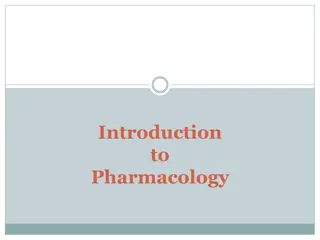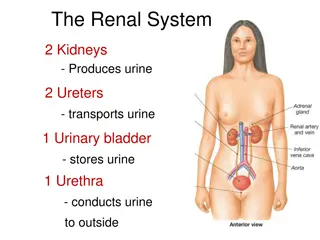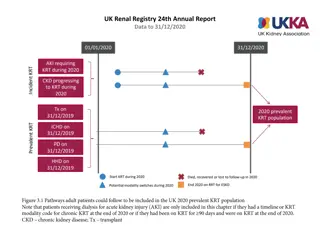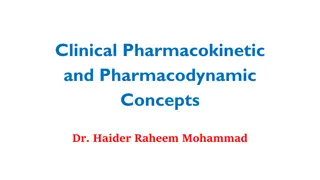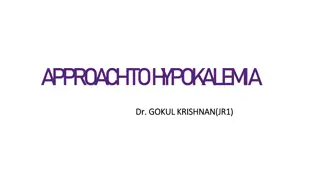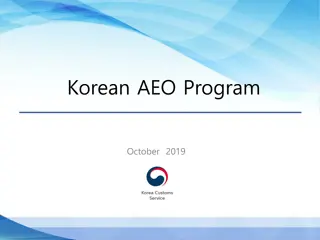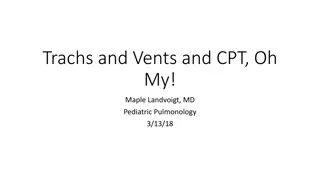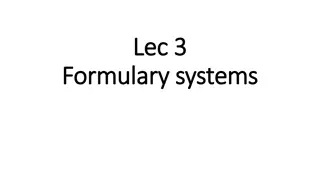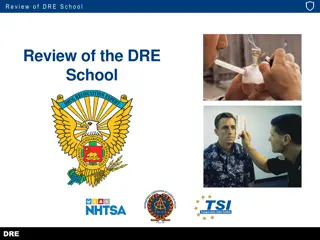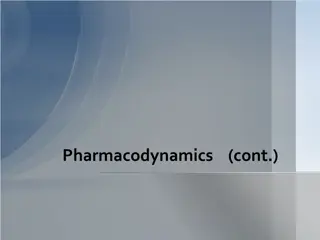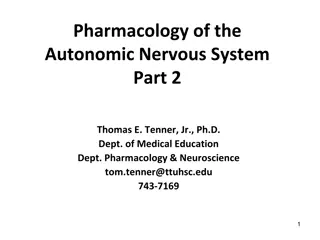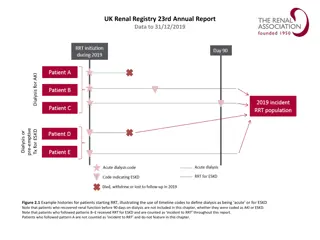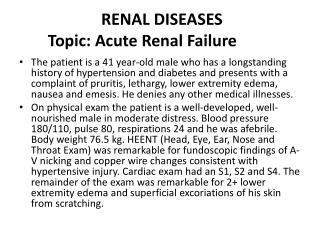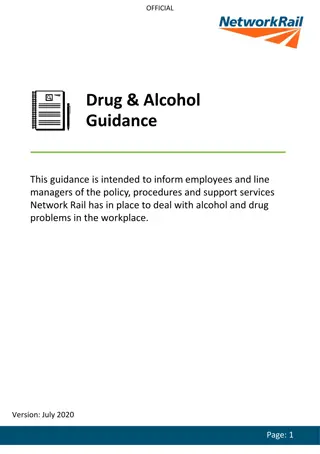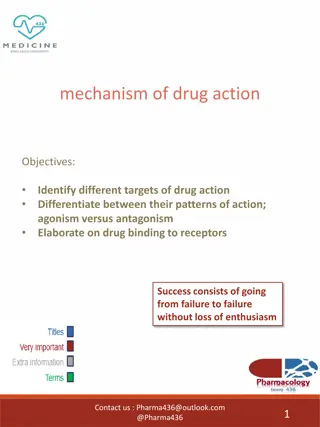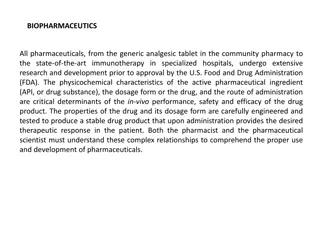Renal Pharmacology: Drug Excretion and Renal Clearance Questions
This comprehensive set of questions and answers covers topics related to drug excretion and renal pharmacology. It includes information on glomerular filtration, drug excretion mechanisms, dosage adjustments in renal impairment, factors influencing drug excretion, and the effects of long-term NSAID usage on renal function. Test your knowledge and understanding of renal drug handling with these direct questions and choose the most likely answers.
Download Presentation

Please find below an Image/Link to download the presentation.
The content on the website is provided AS IS for your information and personal use only. It may not be sold, licensed, or shared on other websites without obtaining consent from the author. Download presentation by click this link. If you encounter any issues during the download, it is possible that the publisher has removed the file from their server.
E N D
Presentation Transcript
Direct questions Choose the most likely answer Poisons and medicine are often the same substance given with different intents. Peter Mere Latham
(1)- the glomerular filtration is high for drugs that are(__) A. ionized B. low in molecular weight (MW) C. unbound to protein D. ALL (2)-which of the following drugs does have a high pH (base)? A. morphine B. atropine C. quinine D. ALL (-ine suffix) (3)-if you a administered penicillin with probenecid; the penicillin t will be (__) A. increased B. decreased C. same D.Steady
(4)- which of the following can be administered in order to increase the excretion for acidic drugs ? A. NaHCO3 B. NH4CL C. sodium bicarbonate D. A&C are the same (5)-which of the following will lead to increase the excretion For morphine ? A. NaHCO3 B. NH4CL C. ammonium chloride D. B&C are the same (6)- which of the following is antibiotic is good for UTI because it gets excreted by the kidney ? A. aminoglycosides B. macrolides C. penicillin D. A&C
(7)- a patient who was using an anti-epileptic drug (100mg tablet every day) and renal clearance becomes Low, what dose/interval adjustment should be done ? A.he should decrease the dose. B. he should increase the dose interval C. he should decrease the dose and increase the interval D. A or B (8)- which of the following factors is directly related to drug excretion ? A. lipid solubility B. volume of distribution C.renal blood flow D. protein binding (9)- a drug that has a constant rate of excretion independent of the plasma concentrations ? A.aminoglycosides B. penicillin C. quinolones
(10)-long term NSAIDs usage can lead to renal failure Why? A. because they their end product is toxic to the kidney B. because they cause non-enzymatic glycosylation C. because they increase PG which are inflammatory mediators D. because they decrease PGI2 and PGE2 which will decease renal perfusion (11)-the sulfamethoxazole-trimethoprim SMX- TMP dosage ratio is? A. SMX/TMP =1/5 B. SMX/TMP=5/1 C. SMX/TMP=1/0.5 D. A&B (12)-which of the following acts on dihydrofolate reductase? A. sulfamethoxazole B. trimethoprim C. dihydropyridine D.A&B
(13)-which of the following is concentrated in the prostate ? A. TMP B. SMX C. A&B D. Non of these (14)-which of the following inhibit DNA gyrase ? A. fluoroquinolones B. aminoglycosides C. tetracycline D. ceftriaxone (15)-which of the following inhibit protein synthesis by acting on 30s subunit ? A. aminoglycosides B. tetracycline C.A&B D. Non of these
(16)-which one of the following is metabolized by acetylation ? A. sulfamethoxazole B. aminoglycosides C. nitrofurantoin D. trimethoprim (17)-which of the following is poorly absorbed orally ,acts in gram negative bacteria ? A. gentamicin B. doxycycline C. ciprofloxacin D. B&C (18)-which of the following should not be taken with milk or Mg ,Fe because they decrease absorption? A. doxycycline B. penicillin C.nitrofurantoin D. trimethoprim
(19)-which one of the following is not a main indications for diuretics in general ? A. edema B. congestive heart failure C. hypertension D. glaucoma (20)-which one of the following is used as used to decrease the intraocular pressure before surgery? A. mannitol B. K sparing diuretics C. thiazide D. furosemide (21)-which one of the following is used to prevent acute renal necrosis after severe injury ? A. mannitol B. acetazolamide C. thiazide D. dorzolamide
(22)-which one of the following is a indicated for Mountain sickness prophylaxis ? A. mannitol B. acetazolamide C. thiazide D. furosemide (23)-which one of the following can t be used with gentamicin ? A. mannitol B. acetazolamide C. thiazide D. furosemide (24)-which one of the following is used in diabetes insipidus ? A. penicillin B. mannitol C. thiazide D. NaHCO3
(25)-which one of the following is used in case of sulfonamide allergy ? A. ethacrynic acid B. furosemide C. bumetanide D. torsemide (26)-which one of the following is suitable for emergency pulmonary edema? A. furosemide B. chlorothiazide C. mannitol D. A&C (27)-which one of the following gets converted to canrenone by the liver ? A. spironolactone B. amiloride C. triamterene D. ALL
(28)-which one of the following is a K sparing diuretic ? A. amiloride B. furosemide C. bumetanide D. torsemide (29)-furosemide can be used in CHF . Due to ? A. K+ sparing effect B. the carbonic anhydrase like action C. Prostaglandin effect D. B&C (30)-which one of the following explains the drug- drug Interaction between NSAIDS and furosemide? A. furosemide will be displaced from it s plasma protein B. the NSAIDS will decrease the bioavailability for furosemide C. the NSAIDS will potentiate the effect of furosemide D. the NSAIDS will decrease furosemide response
(31)-which one of the following is a competitive aldosterone antagonist ? A. spironolactone B. aldosterone C. eplerenone D. A&C (32)- which one of the following is an indirect diuretic? A. spironolactone B. aldosterone C. mannitol D. thiazide (33)-which one of the following is used in lithium induced diabetes insipidus ? A. spironolactone B. aldosterone C. eplerenone D.amiloride
(34)- which one of the following increase the excretion of chloride and decrease the excretion of NH4 ? A. spironolactone B. furosemide C. thiazides D. acetazolamide (35)-which of the following has the slowest onset of action ? A. spironolactone B. furosemide C. thiazides D. acetazolamide (36)-which of the following has the fastest onset of action ? A. spironolactone B. furosemide C. thiazides D. acetazolamide
(37)-a 30 years old man who's having a liver failure, is presented to the clinician with generalized edema , his blood potassium level is(3mEq/L) low which one of the following doesn t undergo a hepatic metabolism and thus can be used in this case ? A. furosemide B. amiloride C. triamterene D. eplerenone (38)-a 44 years old man was brought to the emergency department with malignant hypertension. Which one of the following is the best drug that can be given to restore the blood pressure? A. furosemide B. amiloride C. triamterene D. mannitol
(39)-a 60 years old man with osteoporosis is presented to the clinician with edema and mild hypertension which one of the following is the best to be administered ? A. furosemide B. amiloride C. thiazide D. eplerenone (40)-a 20 years old man with epilepsy is presented to the clinic with mild edema, his doctor administered him a drug for epilepsy and which one of the following diuretics ? A. carbonic anhydrase antagonist B. K+ sparing diuretic C. mannitol D. thiazide
(41)-a 30 years old man is presented to the clinic with oliguria; his blood electrolytes are within the normal range; the blood culture showed that it s a bacterial infection . The doctor prescribed him furosemide and one of the following antibiotics, what is it ? A.gentamicin B. aminoglycosides C. thiazide D. cephalosporin (42)-a 30 years old man is presented to the clinic with essential hypertension, after further investigations we found that he has Liddle syndrome which one of the following drugs is the best to be prescribed ? A. triamterene B. furosemide C. 3rdgeneration cephalosporin D. ciprofloxacin
(43)- which one of the following drugs acts on a membranous Na+ ionic channel ? A.Amiloride B.Furosemide C.Mannitol D.acetazolamide (44)- which one of the following acts on a Na+ transporter? A.Amiloride B.thiazide C.captopril D.Acetazolamide (45)-which one of the following has a fixed amount of excretion regardless of the plasma conc.? A.Alcohol B.Aspirin C.Phenytoin D.ALL
(46)- 35 years old female presented to the clinic with edema she said that she is using her edema treatment in time ,but he took a painkiller And the drug for edema has become less effective .What edema treatment she is using? A. furosemide B.Mannitol C.Acetazolamide D.None of these (47)-a patient presented to the clinic with Deeping and gynecomastia after using a diuretic, what is it? A. triamterene B. furosemide C. 3rd generation cephalosporin D. spironolactone (48)-which one if the following should describe the cause of these side effects (in the previous question) A.Hyperlipidemia caused by carbonic anhydrase block B.Interference with K+ excretion which will increase hair growth C.The interference with androgen D.ALL
(49)-a 33 years old female presented to the clinic with severe volume overload further investigations showed that she s having conns disease which one of the following is the best to be used? A. amiloride B.Spironolactone C.Eplerenone D.thiazide (50)-a 65 years old man presented to the clinic with Severe edema he mentioned that he had done adrenalectomy 2 years ago Which one of the following should be used? A. triamterene B.Amiloride C.Mannitol D.furosemide
(51)-a 30 years old female presented to the clinic with skin rash after taken a loop diuretics, due to a hypersensitivity reaction, which one of the following should be used in this case? A. ethacrynic acid B. Furosemide C. Bumetanide D. torsemide (52)-a 30 years female presented to the clinic with severe edema, he was administered with furosemide and it didn t show any effect Which of the following should be done A. increase the dose B. Use k sparing diuretic C. Use thiazide D. Use ethacrynic acid
answers 40.A 41.D 42.A 43. A 44.B 45.D 46.A 47.D 48.C 49.B 50.D 51.A 52.C 20.A 21.A 22.B 23.D 24.C 25.A 26.A 27.A 28.A 29.C 30.D 31.D 32.C 33.D 34.D 35.A 36.B 37.B 38.A 39.C 40.A 1. D 2. D 3. A 4. D 5. D 6. D 7. D 8. C 9. D 10.D 11.B 12.B 13.A 14.A 15.C 16.A 17.A 18.A 19.D 17.A 18.A 19.D
Side effects Choose the most accurate answer accurate
(1)-which of the following antibiotics can cause megaloblastic anemia by lowering body folate ? A. fluoroquinolones B. aminoglycosides C. tetracycline D. TMP-SMX (2)-which of the following can cause hemolytic anemia and thus contraindicated in G6PD deficiency? A. penicillin B. tetracycline C. nitrofurantoin D. cephalosporins (3)-which of the following can cause damage to the growing cartilage and phototoxicity ? A. nitrofurantoin B. tetracycline C. fluoroquinolones D. B&C
(4)-which of the following can lead to hearing loss ? A. fluoroquinolones B. aminoglycosides C. tetracycline D. TMP-SMX (5)-which of the following can to lead to brown teeth discoloration ? A. gentamicin B. doxycycline C. ciprofloxacin D. amoxicillin (6)-which of the following is not contraindicated in pregnancy? A. cefixime B. doxycycline C. ciprofloxacin D. aminoglycosides
(7)-which one of the following can cause vision disturbance and tingling sensation ? A. acetazolamide B. furosemide C. bumetanide D. torsemide (8)-which one of the following may lead to thrombophlebitis? A. ciprofloxacin B. nitrofurantoin C. cephalosporins D. A&B (9)-which one of the following damage the growing cartilage? A. fluoroquinolones B. nitrofurantoin C. cephalosporins D. gentamicin
(10)-which one of the following can lead to ECF expansion ? A. ethacrynic acid B. furosemide C. mannitol D. torsemide (11)-which of the following can lead to gynecomastia? A. ethacrynic acid B. spironolactone C. amiloride D. eplerenone (12)-which one of the following can precipitate gout and can cause hyperlipidemia ? A. thiazide B. triamterene C. mannitol D.ALL
(13)-which one of the following is the most potent And can lead to fainting ? A. osmotic diuretics B. acetazolamide C. aminoglycosides D. bumetanide (14)-which one of the following can increase LDL ? A. mannitol B. acetazolamide C. thiazide D. ALL (15)-which one of the following can lead to hypercalcemia ? A. mannitol B. acetazolamide C. thiazide D. furosemide
(16)- which one of the following can have a neuromuscular blocking effect and can cause muscle weakness ? A. gentamicin B. carbapenem C. erythromycin D. tetracycline (17)-which one of the following should be avoided in case of CHF? A. mannitol B. furosemide C. torsemide D. ALL (18)-which one of the following blood electrolytes can explain being tired after taking thiazide ? A. increase glucose level in the blood B. increase Ca level in the blood C.Decrease K level in the blood D. ALL
(19)-which one of the following cant precipitate gout ? A. amiloride B. acetazolamide C. thiazide D. furosemide (20)-which one of the following causes alkalosis , urinary acidosis and hypokalemia ? A. mannitol B. acetazolamide C. spironolactone D. furosemide (21)-which one of the following causes metabolic acidosis .urinary alkalosis and hyperkalemia ? A. mannitol B. acetazolamide C. spironolactone D. furosemide
answers 1. D 2. C 3. D 4. B 5. B 6. A 7. A 8. C 9. A 10.C 11.B 12.A 13.D 14.C 15.C 16.A 17.A 18.C 19.B 20.D 21.C
Lippincott's BANK question (might come in real exam) 1-27-year-old woman presents to the emergency department complaining of right flank pain and hematuria. She has passed calcium oxalate stones in the past and likely has another stone. After treating her for the stone, which of the following diuretics could be started to prevent future calcium oxalate stones? Acetazolamide (B) Furosemide (C) Hydrochlorothiazide (D) Mannitol E) Spironolactone
2-A 54-year-old woman with severe essential hypertension refractory to treatment switched to a new antihypertensive drug 1 month ago. Her blood pressure is currently well controlled. She now comes complaining of excessive hair growth. Which antihypertensive drug is she taking? (A) Hydrochlorothiazide (B) Isosorbide dinitrate (C) Minoxidil (D) Nifedipine (E) Nitroglycerin 3-A 63-year-old man presents to the emergency department with worsening heart failure following a myocardial infarction 2 weeks previously. The patient complains of shortness of breath. Physical exam reveals 12 pitting edema in his ankles. Past medical history is significant for an allergic reaction following exposure to trimethoprim sulfamethoxazole. The physician wants to prescribe furosemide as part of this patient s regimen. Which drug should she prescribe him? Acetazolamide (B) Ethacrynic acid (C) Hydrochlorothiazide (D) Mannitol (E) The best drug to use in this case is furosemide
4-A 62-year-old man with congestive heart failure has been taking a loop diuretic to reduce peripheral edema. His labs today reveal low potassium. Which of the following diuretics would be better to use in this patient? (A) acetazolamide (B) Ethacrynic acid (C) Hydrochlorothiazide (D) Methazolamide (E) Triamterene 5-A 47-year-old woman with Type-2 diabetes presents to the nephrology clinic for follow-up. She has been doing well other than an increase in her blood sugars lately. She was started on a new medication recently, but she cannot remember the name. All she knows was it affected her kidneys. What is the most likely medication that she started taking? (A) Acetazolamide (B) Furosemide (C) Hydrochlorothiazide (D) Mannitol (E) Spironolactone
6- A 64-year-old man with left heart failure is managed with digoxin and a thiazide diuretic. His primary care physician orders a laboratory panel. Which of the following electrolytes is most likely to be abnormal in this patient? (A) Calcium (B) Glucose (C) Magnesium (D) Potassium (E) Sodium 7- 52-year-old woman presents to the primary care clinic with progressive weakness and muscle aches for the past month. She can still do her daily tasks but can notice a difference in her strength. When she lies down at night, her legs always ache. Her electrolytes are significant for a K1 of 2.9 mEq/L. She was recently started on a diuretic for peripheral edema. She is pleased that she has not had peripheral edema since starting the diuretic. What is the most appropriate diuretic to treat this patient? (A) Acetazolamide (B) Furosemide (C) Hydrochlorothiazide (D) Mannitol (E) Spironolactone
Answers and Explanations 1- The answer is B: Furosemide. Calcium oxalate stones are caused by an increase of calcium, oxalate, or both in the urine. Stone formation can be avoided by preventing high amounts of calcium from being excreted in the urine. Loop diuretics such as furosemide increase renal excretion of calcium, thereby raising the urinary calcium level and predisposing to stone formation. (A) Amiloride inhibits the sodium potassium exchanger in the distal tubule. It does not raise urinary calcium nearly as much as furosemide and is not associated with an increase in stone formation. (C) Hydrochlorothiazide, by an unknown mechanism, causes calcium retention. It would be a useful drug for this patient because it decreases urinary excretion of calcium. (D) Mannitol is an osmotic diuretic because it is filtered at the glomerulus but minimally reabsorbed. It does not alter calcium handling by the kidney. (E) Spironolactone is an antagonist of aldosterone. Normally, aldosterone causes resorption of sodium from the distal tubules. It does not alter calcium handling by the kidney.
Answers and Explanations 2- The answer is C: Reduction of dietary salt to 10 g/d. Lifestyle modifications to improve blood pressure include the following: weight maintain normal body weight (BMI 18.5 to 24.9); DASH diet rich in fruits, vegetables, grains, low-fat dairy products; and low in fat, cholesterol, and sodium; salt reduce dietary sodium to no more than 2.4 g/d of sodium or 6 g/d of NaCl; exercise regular aerobic activity such as walking (30 min/d on most days); and alcohol limit to no more than two drinks per day for men and one drink per day for women. (A) This is a useful modification that may improve blood pressure. (B) This is a useful modification that may improve blood pressure. (D) This is a useful modification that may improve blood pressure. (E) This is a useful modification that may improve blood pressure
Answers and Explanations 3- The answer is B: Ethacrynic acid. Diuresis is an important aspect of the treatment of heart failure. Putting a patient with heart failure on a diuretic will help keep excess fluid from accumulating in the lungs and other body tissues. One potential problem with diuretics is that most contain a sulfonamide group, which is the antigen responsible for reactions in patients with a sulfa allergy. Of the diuretics listed, only mannitol and ethacrynic acid do not contain a sulfonamide group. Mannitol should not be used because it is contraindicated in patients with heart failure. Ethacrynic acid is a loop diuretic but is structurally not related to other members of that group. It would be the best option in this patient. (A) Acetazolamide contains a sulfonamide group. No sulfonamide should be used in this patient because of his history of a previous allergic reaction. Further exposure could result in anaphylaxis and death. (C) Hydrochlorothiazide contains a sulfonamide group. (D) Mannitol is an osmotic diuretic. It is contraindicated in patients with heart failure because it initially increases circulatory volume and would likely make his swelling and heart failure worse. (E) Furosemide contains a sulfonamide group
Answers and Explanations 4- The answer is E: Triamterene. Potassium-sparing diuretics such as triamterene or amiloride are commonly used in combination with more potent potassium-wasting diuretics (e.g., loop diuretics) or simply in cases of low serum potassium. Potassium is lost in the urine when high amounts of sodium pass through the distal convoluted tubule (as is the case with potassium-wasting diuretics) because of a sodium-potassium exchange pump on the distal tubule cells. Triamterene and amiloride inhibit this pump, leaving sodium in the urine and potassium in the blood. (A) Acetazolamide is a carbonic anhydrase inhibitor and works in the proximal tubule. It causes mild potassium loss in the urine. (B) Loop diuretics such as ethacrynic acid work by inhibiting the Na1/ K1/2Cl2 transporter on the ascending limb of the loop of Henle. Loop diuretics are potassium-wasting diuretics. (C) Hydrochlorothiazide inhibits the sodium chloride symporter in the distal tube. It causes calcium retention by an unknown mechanism but does not cause potassium retention. (D) Methazolamide is a carbonic anhydrase inhibitor and works in the proximal tubule. It causes mild potassium loss in the urine
Answers and Explanations 5-The answer is C: Hydrochlorothiazide. A side effect of hydrochlorothiazide is hyperglycemia. The exact mechanism of the cause of hyperglycemia is unknown; however, it is believed to be through decreased insulin secretion. (A) Acetazolamide can lead to hyperchloremic metabolic acidosis but not commonly hyperglycemia. (B) Furosemide may lead to ototoxicity or hypokalemia but not commonly hyperglycemia. (D) Mannitol may lead to pulmonary edema but not commonly hyperglycemia. (E) Spironolactone may lead to gynecomastia or hyperkalemia but not commonly hyperglycemia.
Answers and Explanations 6- The answer is D: Potassium. Digoxin can cause electrolyte abnormalities. Hypokalemia can precipitate serious arrhythmia. Reduction of serum potassium levels is most frequently observed in patients receiving thiazide or loop diuretics, which can usually be prevented by use of a potassium-sparing diuretic or supplementation with potassium chloride. Hypercalcemia and hypomagnesemia also predispose to digoxin toxicity. (A) Calcium abnormalities are less common than potassium abnormalities. (B) Glucose abnormalities are unlikely unless the patient has diabetes. (C) Magnesium abnormalities are less common than potassium abnormalities. (E) Sodium abnormalities are unlikely in this patient
Answers and Explanations 7-The answer is E: Spironolactone. Spironolactone is a potassium-sparing diuretic that can be used for diuresis. Spironolactone competitively inhibits aldosterone receptors in the collecting tubules. It decreases the secretion of potassium in the urine. (A) Acetazolamide causes the excretion of potassium leading to hypokalemia. (B) Furosemide causes the excretion of potassium leading to hypokalemia. (C) Hydrochlorothiazide causes the excretion of potassium leading to hypokalemia. (D) Mannitol causes the excretion of potassium leading to hypokalemia
USMLE A 50-year-old man presents with a blood pressure of 160/100. He is to be started on hydrochlorothiazide. Which of the following is a common adverse effect of hydrochlorothiazide? A.atrioventricular (AV) blockade B.constipation C.drug-induced lupus erythematosus D.potassium wasting E.Tachycardia Because thiazides decrease the reabsorption of sodium in the distal convoluted tubule, aldosterone secretion is increased and a compensatory response is evoked that releases potassium in response to increased sodium reabsorption in the cortical collecting tubule, therefore, potassium- wasting results. Other adverse effects of thiazides include increased blood glucose, uric acid, and lipids. None of the other choices (AB, E) are adverse effects of thiazide administration. Correct Answer: D
Which of the following drugs causes hyperchloremic metabolic acidosis and may cause hyperammonemia in a patient with cirrhosis ? A.acetazolamide B.amiloride C.furosemide D.hydrochlorothiazide E.spironolactone Explanation/Reference: Explanation: Acetazolamide acts in the proximal tubule to block carbonic anhydrase, greatly increasing bicarbonate excretion and alkalinizing the urine while causing metabolic acidosis. In cirrhosis, ammonia is excreted in larger amounts because urea production in the liver is limited. If an acid urine (necessary for converting ammonia to ammonium ion) cannot be produced, the ammonia is promptly reabsorbed, causing hyperammonemia and hepatic encephalopathy. None of the other drugs (choices BE) causes hyperammonemia in cirrhotic patients. Correct Answer: A Section: Pharmacology Explanation
A 73-year-old woman complains of difficulty sleeping, exercise fatigue, and shortness of breath. Examination reveals mental confusion, swollen ankles, pulmonary rales, and dyspnea while supine. Immediate treatment of the patient may be needed if signs and symptoms, especially those of pulmonary congestion, worsen rapidly. Which of the following would be most beneficial in treating acute, severe pulmonary edema? A. amiloride B. furosemide C. Hydrochlorothiazide D. losartan E. Metoprolol Explanation/Reference: Explanation: Rapid worsening of pulmonary congestion is suggestive of life-threatening acute cardiac decompensation (acute heart failure). Furosemide, a loop diuretic, is one of the most effective agents available because it has powerful diuretic action and also reduces pulmonary vascular pressures. Amiloride (choice A) is a much less efficacious diuretic with primary action in the collecting tubule of the nephron and little or no effect on pulmonary vessels. Hydrochlorothiazide (choice C) is a diuretic of intermediate efficacy that acts in the distal convoluted tubule. Losartan (choice D) is an angiotensin receptor blocker and is not effective in acute reduction of congestive symptoms. Metoprolol (choice E) is a beta adrenoreceptor blocker that is valuable in the long-term, chronic therapy of HF, but not effective (and usually contraindicated) in acute decompensation. Correct Answer: B Section: Pharmacology Explanation
A 35-year-old woman with hypertension is planning to become pregnant. Which of the following is contraindicated in pregnancy? A. clonidine B. hydralazine C. hydrochlorothiazide D. losartan E. methyldopa Explanation/Reference: Explanation: Losartan causes renal damage in the fetus, and renal impairment in renovascular disease. It is contraindicated in pregnancy. Clonidine (choice A) causes some sedation and rebound hypertension when stopped suddenly, but is not contraindicated in pregnancy. Hydralazine (choice B) causes a reversible type of lupus erythematosus. Hydrochlorothiazide (choice C) may cause hypokalemia, dilutional hyponatremia, elevated lipids, hyperuricemia, and glucose intolerance. Methyldopa (choice E) causes sedation and formation of red blood cell antibodies, but has been shown to be safe in pregnancy Correct Answer: D Section: Pharmacology Explanation
A 24-year-old woman presents with hypertension and hypokalemic metabolic alkalosis. Although these symptoms are normally indicative of hyperaldosteronism, this patient's aldosterone levels are undetectable, and no other mineralocorticoid activity is found. A diagnosis of Liddle syndrome is made on the basis of the signs and symptoms and a family history. Liddle syndrome is caused by a genetic defect leading to excessive expression of the apical sodium channel in the principal cells of the cortical- collecting tubule and excess sodium transport in this part of the nephron. Which of the following agents is the best choice for treatment of the hypertension and hypokalemic metabolic alkalosis in this patient? A.amiloride B.fludrocortisones C.hydrochlorothiazide D.lisinopril E.spironolactone Answer in next slide
Correct answer: A Explanation: Treatment of Liddle syndrome consists of direct inhibition of the abnormally expressed sodium channel by either amiloride (choice A) or triamterene, both of which are classified as potassium-sparing diuretics. Triamterene is less useful than amiloride because of its low potency and low solubility, which may lead to the formation of stones. Fludrocortisone (choice B) is a synthetic mineralocorticoid used for replacement therapy in hypoaldosteronism. Although aldosterone levels are reduced in this patient, administration of a mineralocorticoid will exacerbate rather than relieve the hypertension and hypokalemic metabolic alkalosis. Hydrochlorothiazide (choice C), a thiazide diuretic, will exacerbate the problem because inhibition of the N /C symporter in the distal convoluted tubule results in delivery of more sodium to the cortical collecting duct, where the hyperactivity of the sodium channel and resulting potassium extrusion along with increased proton exchange from type A intercalated cells results in greater hypokalemia and alkalosis. Lisinopril (choice D) is an ACE inhibitor used in the treatment of essential hypertension. Spironolactone (choice E) is a selective antagonist at the aldosterone receptor. It is used as a potassium- sparing diuretic. In the case of Liddle disease, spironolactone has no utility; aldosterone does not play a causative role and its levels are already depressed.
A 78-year-old man has ankle edema, tachycardia, and shortness of breath on mild exercise. His blood pressure is 155/98. He has been diagnosed with hypertension and mild heart failure. Which of the following regimens is most appropriate for starting therapy? A. captopril plus dobutamine B. captopril plus hydralazine C. enalapril plus hydrochlorothiazide D. furosemide plus spironolactone E. Losartan plus hydralazine Section: Pharmacology Explanation Explanation/Reference: Explanation: The combination of an ACE inhibitor and a diuretic is rational for this patient with hypertension and mild heart failure as both drugs are effective for both conditions. Furthermore, ACE inhibitors have been shown to slow or stop the progression of heart failure and thiazide diuretics have been shown to be among the cheapest and most effective agents for hypertension. If this combination is not sufficiently active to control the heart failure, a loop diuretic might be substituted for the thiazide. Dobutamine (choice A) is a parenteral drug for acute failure. Hydralazine (choices B, E) is a vasodilator that causes tachycardia and usually requires concurrent administration of a beta blocker. Use of two diuretics choice D) is probably unnecessary in this early stage of failure and is not the most effective therapy for hypertension. Correct Answer: C
Potassium supplementation is often necessary for patients taking large doses of which of the following drugs? A.amiloride B.captopril C.hydrochlorothiazide D.losartan E.Spironolactone Explanation/Reference: Explanation: Hydrochlorothiazide causes potassium wasting and may lead to hypokalemia requiring dietary potassium supplementation. Potassium wasting is characteristic of diuretics that present more sodium to the collecting tubule, where sodium is conserved in exchange for potassium under the control of aldosterone. Therefore, diuretics that act in the proximal convoluted tubule (carbonic anhydrase inhibitors), ascending limb of the loop of Henle (loop diuretics), and distal convoluted tubule (thiazides) cause potassium wasting and may lead to dangerous hypokalemia. Angiotensin antagonists (because they interfere with aldosterone secretion) and aldosterone inhibitors have the opposite effect. Amiloride (choice A) and spironolactone (choice E) are aldosterone antagonists; captopril (choice B) and losartan (choice D) are angiotensin antagonists. The latter agents cause potassium retention and may cause hyperkalemia, not hypokalemia. Correct Answer: C Section: Pharmacology Explanation





